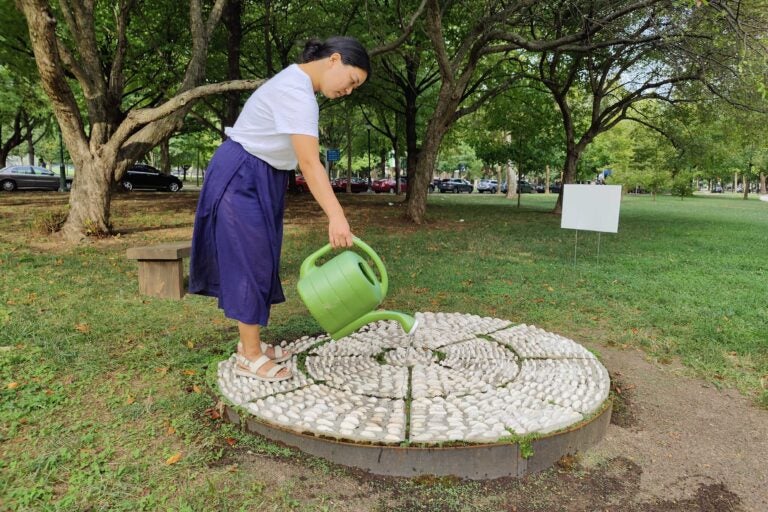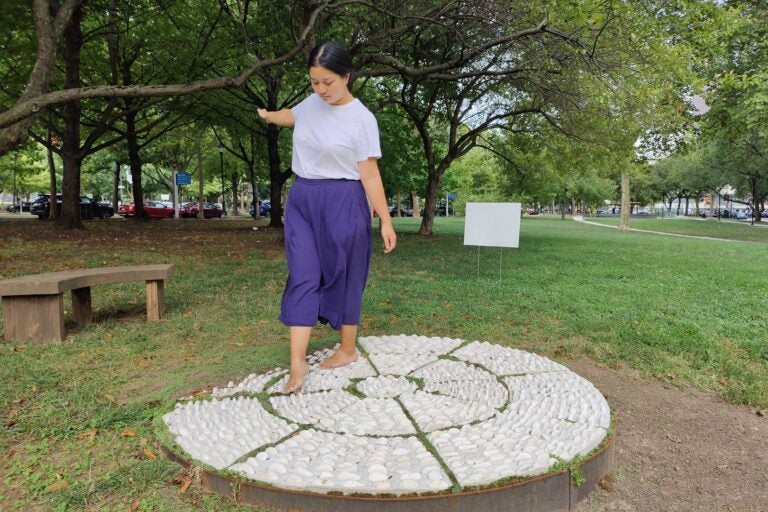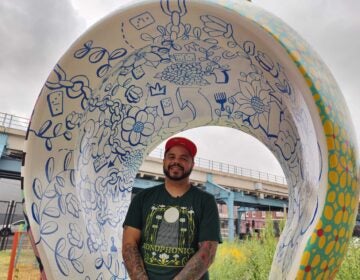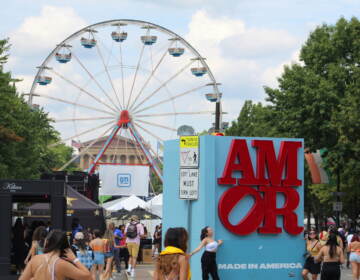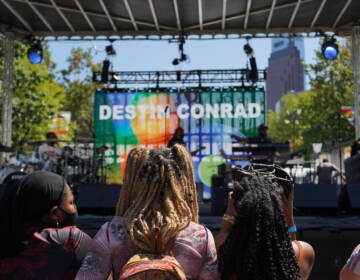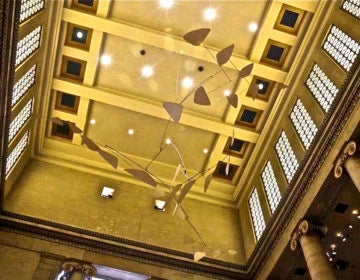A sculpture that probes your sole: ‘The Weight of Our Being’ quietly arrives on the Parkway
Rachel Hsu’s “The Weight of Our Being” is the first piece in a new rotation of temporary sculptures to activate the Parkway.
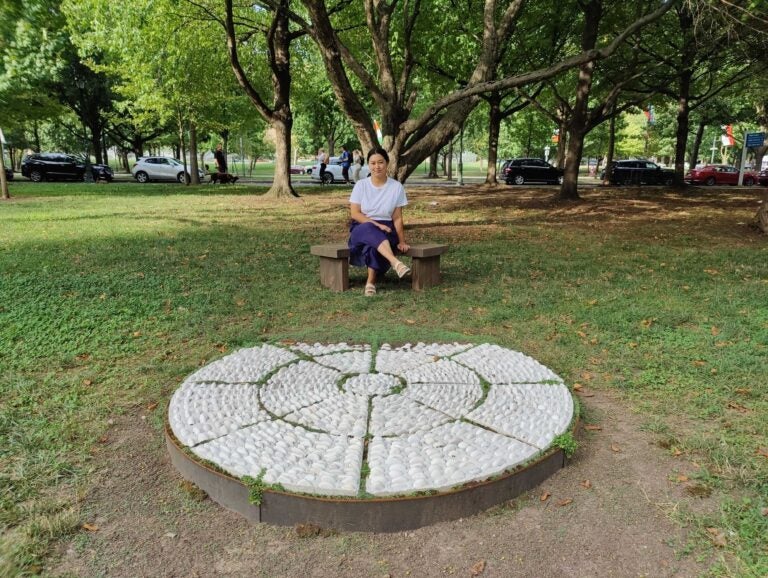
Rachel Hsu's "The Weight of Our Being" is the first commission of the Association for Public Art's new rotation of temporary installation along the Parkway. (Peter Crimmins/WHYY)
From Philly and the Pa. suburbs to South Jersey and Delaware, what would you like WHYY News to cover? Let us know!
A new outdoor sculpture is encouraging passersby to walk all over it and get a massage at the same time. Along Philadelphia’s Benjamin Franklin Parkway in Maja Park at 22nd Street is a circle of concrete embedded with small, rounded stones and partially buried in the turf.
“The Weight of Our Being,” is inspired by reflexology footpaths often seen in Taiwan, where artist Rachel Hsu’s family is from. People are encouraged to take their shoes off and walk barefoot over the stones, which knead delicate bones and pads of the foot.
Similar to acupuncture, the stones exert points of high pressure on nerve endings in your feet to promote well-being.
I tried it, and it hurts.
Your feet have more nerve endings per square inch than any other body part and are vulnerable to the forces between your weight and uneven ground. While the stones are not sharp, they protrude aggressively, peering deeply into your sole.
Experiencing physical pain is part of Hsu’s concept of “The Weight of Our Being.”
“My interest is in delving into the interconnection between sorrow and joy,” she said.
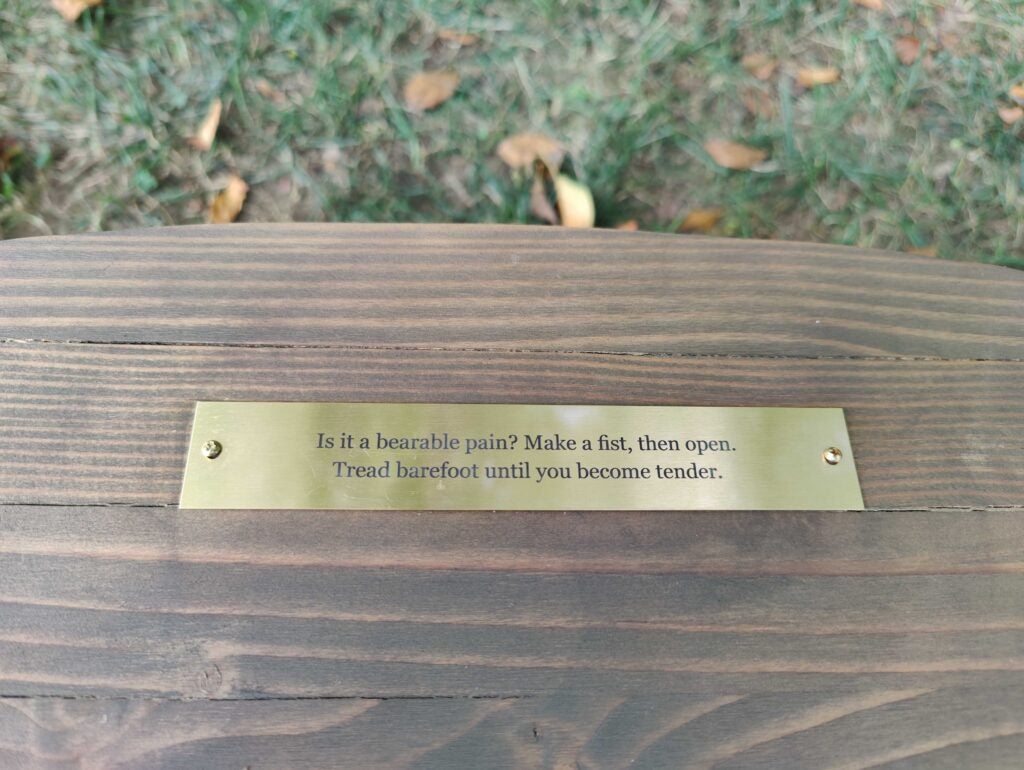
Part of the temporary public artwork is a bench with a plaque that functions as both poetry and instruction manual.
Is it bearable pain? Make a fist, then open.
Tread barefoot until you become tender.
“Like a memorial plaque that you see a lot on benches, like: In memory of Frank, beloved grandfather, or something,” Hsu said. “How can I bring a little bit more grief into this work, a gentle kind of sorrow like an ache, is how I think about it.”
“The Weight of Our Being” is the first of a planned rotation of temporary sculptures to be installed annually along the Parkway by the Association for Public Art (aPA).
In accordance with the Parkway Council’s plan to redesign the Parkway as “more park and less way,” the sculpture series is meant to create areas of interest other than Eakins Oval at the foot of the Art Museum.
“To utilize other parts of the Parkway rather than everyone being just collected at the Oval,” said aPA executive director Charlotte Cohen. “This whole Oval master plan and idea for a Benjamin Franklin Parkway park is to expand this acreage and usage. By using Maja Park, we’re achieving that goal.”
Maja Park is a strip of grass between the Parkway and the Park Towne Place apartment towers where in 2021, aPA installed the figural nude “Maja” by Gerhard Marcks.
The round disk of “The Weight of Our Being” is installed about 50 yards away from “Maja” in a spot deliberately chosen by the artist for the slope of the grade and the curve of the tree boughs suspended overhead.
“This gentle curve that’s happening with the bough, I think of it like a cupped hand,” Hsu said. “It’s like a comfort that’s happening.”
Despite the discomfort it can cause, Hsu’s piece is visually very quiet. It lays flat and partially buried under ground cover plants. Other sculptures near Eakins Oval tend to be showy and shiny: the gold-gilded Joan of Arc, the silver tree of “Simbiosis” and the bright red I-beams of Iroquois.
In contrast “The Weight of Our Being” is subdued, as though shy.
“I think the power of it is because it’s quiet,” Hsu said. “The weight that I’m talking about, this emotional weight, is invisible. But we carry that tension in our bodies.”
The Association for Public Art established a submission process for local artists that was vetted and juried by a panel of local curators. Cohen was hoping something more visually prominent would announce the new public sculpture program.
“I really did think that it might be something big and shiny, that would be vertical and colorful and loud,” she said. “Sometimes you envision something and you get the opposite, and it’s the exact right thing.”
“One of our jurors, Ginger Rudolph, said, ‘It’s the artwork we didn’t know we needed,’” Cohen said. “I have to tell you, it was unanimous.”

Saturdays just got more interesting.
WHYY is your source for fact-based, in-depth journalism and information. As a nonprofit organization, we rely on financial support from readers like you. Please give today.



